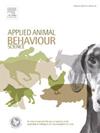多胎母羊在与单胎母羊竞争时交配成功率更高
IF 2.2
2区 农林科学
Q1 AGRICULTURE, DAIRY & ANIMAL SCIENCE
引用次数: 0
摘要
本研究的假设是,多情母羊比无情母羊对公羊更有吸引力,从而导致公羊在竞争环境中表现出更强烈的求偶和交配行为。因此,本研究旨在比较多情或无情发情母羊与性活跃雄性一起或单独进行的性互动。研究使用了 7 只有性经验的科里迪尔公羊、21 只多情母羊和 21 只无情科里迪尔母羊。在检测到发情后立即进行连续 3 天的竞争性性行为和个体性行为测试。每天有 7 只公羊与 7 组不同的多胎母羊和单胎母羊进行测试,每天共测试 14 只母羊。竞争性行为试验是将一只公羊与一只多情母羊和一只无情母羊关在一个围栏中,进行10分钟的评估。在个体性行为测试中,每只公羊与竞争性测试中使用的多产母羊和无产母羊进行两次测试,每次 10 分钟。公羊的性行为在两次试验中均有记录,母羊的行为在竞争性试验中也有记录。在竞争性试验中,公羊先于无产仔母羊接近、交配和嗅闻多产仔母羊(p=0.03;p=0.01;p=0.056)。在这些测试中,公羊与多胎母羊交配的效率高于无胎母羊(p=0.002),这意味着公羊骑乘多胎母羊射精的次数更少。空怀母羊的跳蛋数量和长度均大于多胎母羊(分别为 0.01 和 0.002)。与多胎母羊相比,无阴道母羊的排尿次数更多,持续时间更长,行走次数更多(p=0.01;p=0.06;p=0.08)。在个体性行为测试中,公羊对多胎母羊和单胎母羊的性行为没有差异。总之,多胎母羊比无胎位母羊更喜欢作为性伴侣,公羊与多胎母羊的射精效率更高。这种性吸引力的增加主要是由于母羊发出了诱人的信号,而不是它们的诱导行为。然而,当公羊别无选择时,多产母羊和无产母羊的求偶和交配情况相似,这增加了两组母羊繁殖的可能性。虽然无产仔数母羊更频繁地通过排尿来表明自己的生殖状态,但这一信号并不能弥补多产仔数母羊提供的其他信号,而多产仔数母羊提供的其他信号有助于提高它们的性吸引力。这些研究结果提供了实用的见解,强调了将多胎母羊和无胎母羊分开以优化集体配种繁殖结果的重要性。本文章由计算机程序翻译,如有差异,请以英文原文为准。
Multiparous ewes have greater mating success when competing with nulliparous ones
The hypothesis of this study was that multiparous ewes are more attractive to rams than nulliparous ewes, leading to more intense courtship and mating displays by rams in competitive environments. Thus, this study aimed to compare the sexual interactions of multiparous or nulliparous estrous ewes tested together or individually with sexually active males. Seven sexually experienced Corriedale rams, 21 multiparous, and 21 nulliparous Corriedale ewes were used. Competitive and individual sexual behavior tests were performed for 3 consecutive days immediately after estrous detection. Seven rams were tested with seven different dyads of one multiparous and one nulliparous female daily, totaling 14 ewes per day. The competitive sexual behavioral test evaluated a ram together in a pen with one multiparous ewe and one nulliparous ewe for 10 min. In the individual sexual behavioral test, each ram was tested twice for 10 min, with the same multiparous and nulliparous females used in the competitive sexual tests. The sexual behaviors of rams were recorded in both tests, and ewes' behaviors were registered in the competitive sexual tests. During the competitive sexual tests, rams approached, mated, and tended to sniff the multiparous ewes before the nulliparous ewes (p=0.03; p=0.01; p=0.056, respectively). In those tests, rams mated the multiparous ewes more efficiently than nulliparous ones (p=0.002), meaning that rams mounted multiparous fewer times to ejaculate. The number of flehmens and their length were greater in nulliparous than in multiparous (0.01 and 0.002, respectively). The nulliparous ewes urinated more times and tended to do it in greater duration and tended to walk more than the multiparous (p=0.01; p=0.06; p=0.08, respectively). During the individual sexual behavioral tests, rams showed no differences in the sexual behaviors displayed toward multiparous and nulliparous females. In conclusion, multiparous ewes were preferred as sexual partners over nulliparous ewes, with rams showing greater efficiency in ejaculating with multiparous ewes. This increased sexual attractiveness was primarily due to the ewes' attractive signals rather than their proceptive behaviors. However, multiparous and nulliparous ewes were courted and mated similarly when rams had no choice, increasing the likelihood of reproduction in both groups. While nulliparous ewes signaled their reproductive status more frequently through urination, this signal did not compensate for the other signals provided by multiparous ewes, which contributed to their higher sexual attractiveness. These findings offer practical insights, emphasizing the importance of separating multiparous and nulliparous ewes to optimize reproductive outcomes in collective breedings.
求助全文
通过发布文献求助,成功后即可免费获取论文全文。
去求助
来源期刊

Applied Animal Behaviour Science
农林科学-行为科学
CiteScore
4.40
自引率
21.70%
发文量
191
审稿时长
18.1 weeks
期刊介绍:
This journal publishes relevant information on the behaviour of domesticated and utilized animals.
Topics covered include:
-Behaviour of farm, zoo and laboratory animals in relation to animal management and welfare
-Behaviour of companion animals in relation to behavioural problems, for example, in relation to the training of dogs for different purposes, in relation to behavioural problems
-Studies of the behaviour of wild animals when these studies are relevant from an applied perspective, for example in relation to wildlife management, pest management or nature conservation
-Methodological studies within relevant fields
The principal subjects are farm, companion and laboratory animals, including, of course, poultry. The journal also deals with the following animal subjects:
-Those involved in any farming system, e.g. deer, rabbits and fur-bearing animals
-Those in ANY form of confinement, e.g. zoos, safari parks and other forms of display
-Feral animals, and any animal species which impinge on farming operations, e.g. as causes of loss or damage
-Species used for hunting, recreation etc. may also be considered as acceptable subjects in some instances
-Laboratory animals, if the material relates to their behavioural requirements
 求助内容:
求助内容: 应助结果提醒方式:
应助结果提醒方式:


